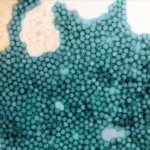Link to Pubmed [PMID] – 21994791
Viruses 2011 Aug;3(8):1460-84
Genetic recombination in RNA viruses was discovered many years ago for poliovirus (PV), an enterovirus of the Picornaviridae family, and studied using PV or other picornaviruses as models. Recently, recombination was shown to be a general phenomenon between different types of enteroviruses of the same species. In particular, the interest for this mechanism of genetic plasticity was renewed with the emergence of pathogenic recombinant circulating vaccine-derived polioviruses (cVDPVs), which were implicated in poliomyelitis outbreaks in several regions of the world with insufficient vaccination coverage. Most of these cVDPVs had mosaic genomes constituted of mutated poliovaccine capsid sequences and part or all of the non-structural sequences from other human enteroviruses of species C (HEV-C), in particular coxsackie A viruses. A study in Madagascar showed that recombinant cVDPVs had been co-circulating in a small population of children with many different HEV-C types. This viral ecosystem showed a surprising and extensive biodiversity associated to several types and recombinant genotypes, indicating that intertypic genetic recombination was not only a mechanism of evolution for HEV-C, but an usual mode of genetic plasticity shaping viral diversity. Results suggested that recombination may be, in conjunction with mutations, implicated in the phenotypic diversity of enterovirus strains and in the emergence of new pathogenic strains. Nevertheless, little is known about the rules and mechanisms which govern genetic exchanges between HEV-C types, as well as about the importance of intertypic recombination in generating phenotypic variation. This review summarizes our current knowledge of the mechanisms of evolution of PV, in particular recombination events leading to the emergence of recombinant cVDPVs.

